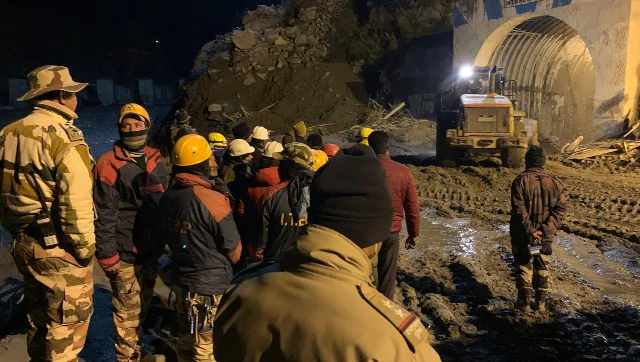
The toll from the Uttarakhand glacier disaster rose to 31 with five more bodies being recovered, officials said on Tuesday as multiple agencies raced against time to reach about 30 workers trapped inside a tunnel in a power project site and 175 people remained missing.
Huge boulders embedded in the debris inside the Tapovan tunnel are causing the biggest hindrance to the ongoing search operations at the NTPC’s damaged hydel project site, ITBP deputy commandant AK Dabral said.
Around 25 to 35 people are feared trapped in the tunnel since the avalanche hit Joshimath area of Chamoli district on Sunday with rescue efforts by multiple agencies focused on reaching them as soon as possible.
The combined rescue team has reached up to 130 metres inside the tunnel but there is a lot of debris clogging it, he said. People feared trapped inside the tunnel should be around 200 metres, he said.
Personnel of the army, State Disaster Response Force, National Disaster Response Force, Sashastra Seema Bal are coordinating and working with a defined strategy to get to those trapped inside, Dabral said.
However, some feel that more sophisticated equipment should be engaged to expedite the rescue operations.
Kedarnath MLA Manoj Rawat said excavators and Pokland machines should be brought in to speed up the process.
‘Collapse of weakened rock mass may have caused flash floods’
A rock mass weakened over a period of time due to freezing and thawing of snow must have led to the creation of a “weak zone”, triggering its collapse, which resulted in the formation of a temporary dam that eventually breached, causing the deadly floods in Uttarakhand’s Chamoli district on Sunday, initial observations by scientists of the Wadia Institute of Himalayan Geology (WIHG) suggest.
Kalachand Sain, Director of the WIHG, said the incident occurred adjacent to the Raunthi glacier. The area also has glaciers that feed the Rishi Ganga river, which ultimately joins the Dhauli Ganga.
Sain said the avalanche must have taken place in the wee hours of Sunday while the temporary dam must have breached between 10-11 am.
Two teams comprising five glaciologists of the WIHG are at the site conducting observations. The teams carried out a helicopter survey of the area on Tuesday to find clues as to what led to the massive flash floods that swept everything on the way.
“Our observations suggest that the rock mass may have weakened due to freezing and thawing over a period of time. This sometimes leads to the development of a weak zone and fractures,” Sain said.
The area also witnessed precipitation in the preceding three days, followed by clear weather on the day of the event, which caused a freezing and thawing effect.
“The event occurred due to a slide of a large rock mass beneath the hanging glacier at 5,600 metres above sea level. It was observed that a huge rock and glacial ice masses collectively moved rapidly down the valley, taking away along with them all the snow and other loose material coming their way,” Sain said.
The steep slopes of the mountains in the region further increased the intensity of the crash. The stretch of the avalanche was about three kilometres with an average slope of 37 degrees, before reaching the “Raunthi Nala/Gadhera” floor at an altitude of about 3,600 metres.
Thus, the rock-and-snow avalanche was able to entrain a vast amount of water and sediment.
“It seems that the materials blocked the water to the Raunthi Nala stream, causing a temporary water impoundment. The impounded water was eventually breached, which might have caused the catastrophic flash floods,” Sain said.
An institute under the Department of Science and Technology (DST), the WIHG studies the Himalayan environment and its geology. Sain said an initial report will be sent to the DST.
Earlier, this morning, two bodies were recovered from the debris in Raini village, National Disaster Response Force (NDRF) officials said, two days after a portion of the Nanda Devi glacier possibly burst its banks and triggered an avalanche and floods in the Alaknanda river system.
Toll at 31, around 175 missing
The State Emergency Operation Centre said five bodies were found in the morning, taking the death toll to 31, and estimated that 175 people are still missing.
With the hours ticking by inexorably, fears escalated about those missing since the disaster struck on Sunday morning, according to officials who stepped up efforts to locate survivors.
The missing people include those working at NTPC’s 480 MW Tapovan-Vishnugad project and the 13.2 MW Rishiganga Hydel Project and villagers whose homes nearby were washed away.
Teams of the Army, Indo-Tibetan Border Police (ITBP), National Disaster Response Force (NDRF) and State Disaster Response Force (SDRF) coordinated efforts to rescue about 30 people who were working in a tunnel at the Tapovan-Vishnugad project when the waters came rushing in.
The workers have been trapped in the 12-ft-high and about 2.5-km-long ”head race tunnel” (HRT).
“Clearing of debris and slush continued the whole night. About 120 metres of the tunnel entrance stretch is now clear,” ITBP spokesperson Vivek Kumar Pandey said in Delhi.
“The height of the accumulated slush has reduced more. ITBP personnel are waiting to enter as soon as any movement deep inside the tunnel is possible,” he said.
A senior official added that the rescuers have not been able to make any contact with those stuck inside but are hopeful for “signs of life”.
Relief is also being distributed by helicopters among villagers cut off due to the washing away of a bridge in the avalanche at Malari.
About 100 ration kits have been distributed in the affected areas of 13 villages with a total population of around 2,500, officials said.
The villages that lost road connectivity in the wake of the calamity are Raini Palli, Pang, Lata, Suraithota, Suki, Bhalgaon, Tolma, Fagrasu, Long Segdi, Gahar, Bhangyul, Juwagwad and Jugju. On Tuesday, Uttarakhand chief minister Trivendra Singh Rawat undertook an aerial survey of the affected areas, visited the ITBP hospital in Joshimath, about 295 km from Dehradun, and met the 12 workers who were rescued from a small tunnel in Tapovan on Sunday evening.
Additional heavy machines could be pressed into service to expedite the process of clearing the tonnes of debris inside the tunnel, blocking the path of rescue personnel.
The clearing of slush and debris is a painstaking exercise but the multi-agency group of rescuers are there in large numbers and taking turns to dig in deeper with the help of heavy machines, officials said.
The teams have been working since Sunday to clear the tunnel and rescue the trapped.
As the temperature dipped to freezing levels at the site, awash with slush, silt and debris, bonfires were lit at multiple locations to keep the rescuers warm.
The tunnel has become the focal point of rescue operations.
While the ITBP has deployed as many as 300 personnel for conducting rescue operations at this site, many NDRF, SDRF and army personnel are also present.
The ITBP and other rescuers are carrying tall wooden planks which are being used by rescuers to wade in through the slush and will later also help create a platform to pull out the trapped people using ropes.
Pandey had earlier said these teams are ready with dragon light sets, oxygen cylinders and stretchers to provide immediate medical help to those trapped inside
‘Personnel trying hard’
The chief minister said the pace of rescue operation at the Tapovan tunnel has slowed down due to the flow of slush but efforts are on to reach those trapped inside by drilling through the debris with the help of ropes. “Undaunted multi-agency security personnel are trying hard to make their way through the tunnel. Let us see how many lives we can save,” Rawat told reporters.
Meanwhile, Haryana chief minister Manohar Lal Khattar on Tuesday gave Rs 11 crore as financial aid from the Chief Minister’s Relief Fund to the Uttarakhand State Disaster Response Fund in the wake of the glacier tragedy in the hill state.
In this hour of tragedy and crisis, the Haryana government stands with Uttarakhand, and every possible help will be given to the state to deal with the disaster, Khattar said in an official statement.
With inputs from PTI
This article is auto-generated by Algorithm Source: www.firstpost.com


